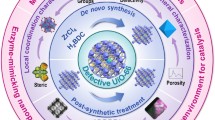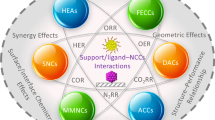Abstract
Downsizing to sub-nm is a general strategy to reduce the cost of catalysts. However, theoretical Wulff-constructed model suggests that sub-nm clusters show little activity for various reactions such as ammonia decomposition and ammonia synthesis because of the lack of active sites. As clusters may deviate from the ideal model construction under reaction conditions, a host–guest strategy to synthesize thermally stable 1.0 nm monodispersed Ru clusters by the pyrolysis of MIL-101 hosts is reported here to verify the hypothesis. For ammonia decomposition, the activity of the Ru clusters is 25 times higher than that of commercial Ru/active carbon (AC) at full-conversion temperature, while for ammonia synthesis, the activity of the Ru clusters is 500 times as high as that of promoted Ru NPs counterpart. The catalyst also maintains its activities for 40 h without any increase in the size. This model can be used to develop a host–guest strategy for designing thermally stable sub-nm clusters to atomic–efficiently catalyze reactions.

Similar content being viewed by others
References
Spencer, N. D.; Schoonmaker, R. C.; Somorjai, G. A. Structure sensitivity in the iron single-crystal catalysed synthesis of ammonia. Nature 1981, 294, 643–644.
Rodriguez, J. A.; Goodman, D. W. High-pressure catalytic reactions over single-crystal metal surfaces. Surf. Sci. Rep. 1991, 14, 1–107.
Liu, J. X.; Su, H. Y.; Sun, D. P.; Zhang, B. Y.; Li, W. X. Crystallographic dependence of CO activation on cobalt catalysts: HCP versus FCC. J. Am. Chem. Soc. 2013, 135, 16284–16287.
Li, W. Z.; Liu, J. X.; Gu, J.; Zhou, W.; Yao, S. Y.; Si, R.; Guo, Y.; Su, H. Y.; Yan, C. H.; Li, W. X. et al. Chemical insights into the design and development of face-centered cubic ruthenium catalysts for Fischer–Tropsch synthesis. J. Am. Chem. Soc. 2017, 139, 2267–2276.
Marks, L. D. Experimental studies of small particle structures. Rep. Prog. Phys. 1994, 57, 603–649.
Honkala, K.; Hellman, A.; Remediakis, I. N.; Logadottir, A.; Carlsson, A.; Dahl, S.; Christensen, C. H.; Nørskov, J. K. Ammonia synthesis from first-principles calculations. Science 2005, 307, 555–558.
Dahl, S.; Logadottir, A.; Egeberg, R. C.; Larsen, J. H.; Chorkendorff, I.; Törnqvist, E.; Nørskov, J. K. Role of steps in N2 activation on Ru(0001). Phys. Rev. Lett. 1999, 83, 1814–1817.
Vajda, S.; Pellin, M. J.; Greeley, J. P.; Marshall, C. L.; Curtiss, L. A.; Ballentine, G. A.; Elam, J. W.; Catillon- Mucherie, S.; Redfern, P. C.; Mehmood, F. et al. Subnanometre platinum clusters as highly active and selective catalysts for the oxidative dehydrogenation of propane. Nat. Mater. 2009, 8, 213–216.
Oliver-Meseguer, J.; Cabrero-Antonino, J. R.; Domínguez, I.; Leyva-Pérez, A.; Corma, A. Small gold clusters formed in solution give reaction turnover numbers of 107 at room temperature. Science 2012, 338, 1452–1455.
Wei, H. S.; Liu, X. Y.; Wang, A. Q.; Zhang, L. L.; Qiao, B. T.; Yang, X. F.; Huang, Y. Q.; Miao, S.; Liu, J. Y.; Zhang, T. FeOx-supported platinum single-atom and pseudo-single-atom catalysts for chemoselective hydrogenation of functionalized nitroarenes. Nat. Commun. 2014, 5, 5634.
Tyo, E. C.; Vajda, S. Catalysis by clusters with precise numbers of atoms. Nat. Nanotechnol. 2015, 10, 577–588.
Meek, S. T.; Greathouse, J. A.; Allendorf, M. D. Metalorganic frameworks: A rapidly growing class of versatile nanoporous materials. Adv. Mater. 2011, 23, 249–267.
Tao, F.; Dag, S.; Wang, L. W.; Liu, Z.; Butcher, D. R.; Bluhm, H.; Salmeron, M.; Somorjai, G. A. Break-up of stepped platinum catalyst surfaces by high CO coverage. Science 2010, 327, 850–853.
Tao, F.; Grass, M. E.; Zhang, Y. W.; Butcher, D. R.; Renzas, J. R.; Liu, Z.; Chung, J. Y.; Mun, B. S.; Salmeron, M.; Somorjai, G. A. Reaction-driven restructuring of Rh-Pd and Pt-Pd core-shell nanoparticles. Science 2008, 322, 932–934.
Jacobsen, C. J. H.; Dahl, S.; Hansen, P. L.; Tornqvist, E.; Jensen, L.; Topsøe, H.; Prip, D. V.; Møenshaug, P. B.; Chorkendorff, I. Structure sensitivity of supported ruthenium catalysts for ammonia synthesis. J. Mol. Catal. A: Chem. 2000, 163, 19–26.
Kalamaras, C. M.; Americanou, S.; Efstathiou, A. M. “Redox” vs. “associative formate with–OH group regeneration” WGS reaction mechanism on Pt/CeO2: Effect of platinum particle size. J. Catal. 2011, 279, 287–300.
Corma, A. From microporous to mesoporous molecular sieve materials and their use in catalysis. Chem. Rev. 1997, 97, 2373–2420.
Goel, S.; Wu, Z. J.; Zones, S. I.; Iglesia, E. Synthesis and catalytic properties of metal clusters encapsulated within small-pore (SOD, GIS, ANA) zeolites. J. Am. Chem. Soc. 2012, 134, 17688–17695.
Liu, Y. L.; Tang, Z. Y. Multifunctional Nanoparticle@MOF core–shell nanostructures. Adv. Mater. 2013, 25, 5819–5825.
Guan, B. Y.; Yu, X. Y.; Wu, H. B.; Lou, X. W. Complex nanostructures from materials based on metal-organic frameworks for electrochemical energy storage and conversion. Adv. Mater., 2017, 29, 1703614.
Pan, X. L.; Fan, Z. L.; Chen, W.; Ding, Y. J.; Luo, H. Y.; Bao, X. H. Enhanced ethanol production inside carbonnanotube reactors containing catalytic particles. Nat. Mater. 2007, 6, 507–511.
Volosskiy, B.; Niwa, K.; Chen, Y.; Zhao, Z. P.; Weiss, N. O.; Zhong, X.; Ding, M. N.; Lee, C.; Huang, Y.; Duan, X. F. Metal-organic framework templated synthesis of ultrathin, well-aligned metallic nanowires. ACS Nano 2015, 9, 3044–3049.
Chen, Y. Z.; Zhou, Y. X.; Wang, H. W.; Lu, J. L.; Uchida, T.; Xu, Q.; Yu, S. H.; Jiang, H. L. Multifunctional PdAg@MIL-101 for one-pot cascade reactions: Combination of host–guest cooperation and bimetallic synergy in catalysis. ACS Catal. 2015, 5, 2062–2069.
Wu, S. S.; Zhu, Y. G.; Huo, Y. F.; Luo, Y. C.; Zhang, L. H.; Wan, Y.; Nan, B.; Cao, L. J.; Wang, Z. Y.; Li, M. C. et al. Bimetallic organic frameworks derived CuNi/carbon nanocomposites as efficient electrocatalysts for oxygen reduction reaction. Sci. China Mater. 2017, 60, 654–663.
Wang, B. Q.; Liu, W. X.; Zhang, W. N.; Liu, J. F. Nanoparticles@nanoscale metal-organic framework composites as highly efficient heterogeneous catalysts for size- and shape-selective reactions. Nano Res. 2017, 10, 3826–3835.
Li, X. L.; Zhang, B. Y.; Tang, L. L.; Goh, T. W.; Qi, S. Y.; Volkov, A.; Pei, Y. C.; Qi, Z. Y.; Tsung, C.-K.; Stanley, L. et al. Cooperative multifunctional catalysts for nitrone synthesis: Platinum nanoclusters in amine-functionalized metal–organic frameworks. Angew. Chem., Int. Ed. 2017, 56, 16371–16375.
Li, X. L.; Goh, T. W.; Li, L.; Xiao, C. X.; Guo, Z. Y.; Zeng, X. C.; Huang, W. Y. Controlling catalytic properties of Pd nanoclusters through their chemical environment at the atomic level using isoreticular metal–organic frameworks. ACS Catal. 2016, 6, 3461–3468.
Li, X. L.; Guo, Z. Y.; Xiao, C. X.; Goh, T. W.; Tesfagaber, D.; Huang, W. Y. Tandem catalysis by palladium nanoclusters encapsulated in metal–organic frameworks. ACS Catal. 2014, 4, 3490–3497.
Guo, Z. Y.; Xiao, C. X.; Maligal-Ganesh, R. V.; Zhou, L.; Goh, T. W.; Li, X. L.; Tesfagaber, D.; Thiel, A.; Huang, W. Y. Pt Nanoclusters confined within metal–organic framework cavities for chemoselective cinnamaldehyde hydrogenation. ACS Catal. 2014, 4, 1340–1348.
Boisen, A.; Dahl, S.; Nørskov, J. K.; Christensen, C. H. Why the optimal ammonia synthesis catalyst is not the optimal ammonia decomposition catalyst. J. Catal. 2005, 230, 309–312.
Férey, G.; Mellot-Draznieks, C.; Serre, C.; Millange, F.; Dutour, J.; Surblé, S.; Margiolaki, I. A chromium terephthalatebased solid with unusually large pore volumes and surface area. Science 2005, 309, 2040–2042.
Yin, S. F.; Xu, B. Q.; Zhou, X. P.; Au, C. T. A mini-review on ammonia decomposition catalysts for on-site generation of hydrogen for fuel cell applications. Appl. Catal. A: Gen. 2004, 277, 1–9.
Aika, K.; Ohya, A.; Ozaki, A.; Inoue, Y.; Yasumori, I. Support and promoter effect of ruthenium catalyst: II. Ruthenium/alkaline earth catalyst for activation of dinitrogen. J. Catal. 1985, 92, 305–311.
Aika, K.; Takano, T.; Murata, S. Preparation and characterization of chlorine-free ruthenium catalysts and the promoter effect in ammonia synthesis: 3. A magnesiasupported ruthenium catalyst. J. Catal. 1992, 136, 126–140.
Kubota, J.; Aika, K. Infrared studies of adsorbed dinitrogen on supported ruthenium catalysts for ammonia synthesis: Effects of the alumina and magnesia supports and the cesium compound promoter. J. Phys. Chem. 1994, 98, 11293–11300.
Larichev, Y. V. Valence state study of supported ruthenium Ru/MgO catalysts. J. Phys. Chem. C 2008, 112, 14776–14780.
Ge, J. J.; He, D. S.; Chen, W. X.; Ju, H. X.; Zhang, H.; Chao, T. T.; Wang, X. Q.; You, R.; Lin, Y.; Wang, Y. et al. Atomically dispersed Ru on ultrathin Pd nanoribbons. J. Am. Chem. Soc. 2016, 138, 13850–13853.
Kitano, M.; Inoue, Y.; Yamazaki, Y.; Hayashi, F.; Kanbara, S.; Matsuishi, S.; Yokoyama, T.; Kim, S. W.; Hara, M.; Hosono, H. Ammonia synthesis using a stable electride as an electron donor and reversible hydrogen store. Nat. Chem. 2012, 4, 934–940.
Kitano, M.; Kanbara, S.; Inoue, Y.; Kuganathan, N.; Sushko, P. V.; Yokoyama, T.; Hara, M.; Hosono, H. Electride support boosts nitrogen dissociation over ruthenium catalyst and shifts the bottleneck in ammonia synthesis. Nat. Commun. 2015, 6, 6731.
Wang, P. K.; Chang, F.; Gao, W. B.; Guo, J. P.; Wu, G. T.; He, T.; Chen, P. Breaking scaling relations to achieve lowtemperature ammonia synthesis through LiH-mediated nitrogen transfer and hydrogenation. Nat. Chem. 2017, 9, 64–70.
Rosowski, F.; Hornung, A.; Hinrichsen, O.; Herein, D.; Muhler, M.; Ertl, G. Ruthenium catalysts for ammonia synthesis at high pressures: Preparation, characterization, and power-law kinetics. Appl. Catal. A: Gen. 1997, 151, 443–460.
Rossetti, I.; Sordelli, L.; Ghigna, P.; Pin, S.; Scavini, M.; Forni, L. EXAFS−XANES evidence of in situ cesium reduction in Cs−Ru/C catalysts for ammonia synthesis. Inorg. Chem. 2011, 50, 3757–3765.
Larichev, Y. V. Effect of Cs+ promoter in Ru/MgO catalysts. J. Phys. Chem. C 2011, 115, 631–635.
Gao, Y.; Bai, G.; Liang, Y.; Dunham, G. C.; Chambers, S. A. Structure and surface morphology of highly conductive RuO2 films grown on MgO by oxygen-plasma-assisted molecular beam epitaxy. J. Mater. Res. 1997, 12, 1844–1849.
Schlögl, R. Catalytic synthesis of ammonia—A “never-ending story”? Angew. Chem., Int. Ed. 2003, 42, 2004–2008.
Liu, H. Z. Ammonia synthesis catalyst 100 years: Practice, enlightenment and challenge. Chinese J. Catal. 2014, 35, 1619–1640.
Choudhary, T. V.; Sivadinarayana, C.; Goodman, D. W. Catalytic ammonia decomposition: COx-free hydrogen production for fuel cell applications. Catal. Lett. 2001, 72, 197–201.
Klerke, A.; Christensen, C. H.; Nørskov, J. K.; Vegge, T. Ammonia for hydrogen storage: Challenges and opportunities. J. Mater. Chem. 2008, 18, 2304–2310.
Hayashi, F.; Toda, Y.; Kanie, Y.; Kitano, M.; Inoue, Y.; Yokoyama, T.; Hara, M.; Hosono, H. Ammonia decomposition by ruthenium nanoparticles loaded on inorganic electride C12A7:e−. Chem. Sci. 2013, 4, 3124–3130.
García-Bordejé, E.; Armenise, S.; Roldán, L. Toward practical application of H2 generation from ammonia decomposition guided by rational catalyst design. Catal. Rev. 2014, 56, 220–237.
Guo, J. P.; Wang, P. K.; Wu, G. T.; Wu, A. A.; Hu, D. Q.; Xiong, Z. T.; Wang, J. H.; Yu, P.; Chang, F.; Chen, Z. et al. Lithium imide synergy with 3d transition-metal nitrides leading to unprecedented catalytic activities for ammonia decomposition. Angew. Chem., Int. Ed. 2015, 54, 2950–2954.
Kowalczyk, Z.; Sentek, J.; Jodzis, S.; Mizera, E.; Góralski, J.; Paryjczak, T.; Diduszko, R. An alkali-promoted ruthenium catalyst for the synthesis of ammonia, supported on thermally modified active carbon. Catal. Lett. 1997, 45, 65–72.
Acknowledgements
This work was supported by the National Natural Science Foundation of China (Nos. 21521091, 21131004, 21390393, U1463202, 21573119, 21590792, and 21406184). We also thank the Shanghai Synchrotron Radiation Facility (No. BL14W1) for providing beam time.
Author information
Authors and Affiliations
Corresponding authors
Electronic supplementary material
12274_2018_2062_MOESM3_ESM.pdf
Sub-nm ruthenium cluster as an efficient and robust catalyst for decomposition and synthesis of ammonia: Break the “size shackles”
Rights and permissions
About this article
Cite this article
Li, J., Wang, W., Chen, W. et al. Sub-nm ruthenium cluster as an efficient and robust catalyst for decomposition and synthesis of ammonia: Break the “size shackles”. Nano Res. 11, 4774–4785 (2018). https://doi.org/10.1007/s12274-018-2062-4
Received:
Revised:
Accepted:
Published:
Issue Date:
DOI: https://doi.org/10.1007/s12274-018-2062-4




